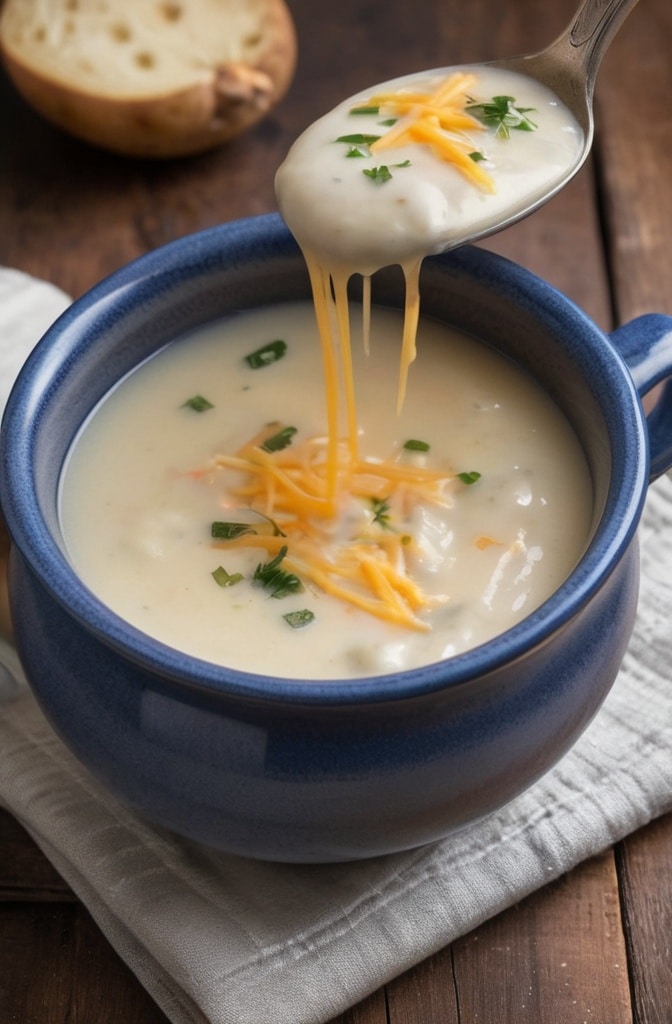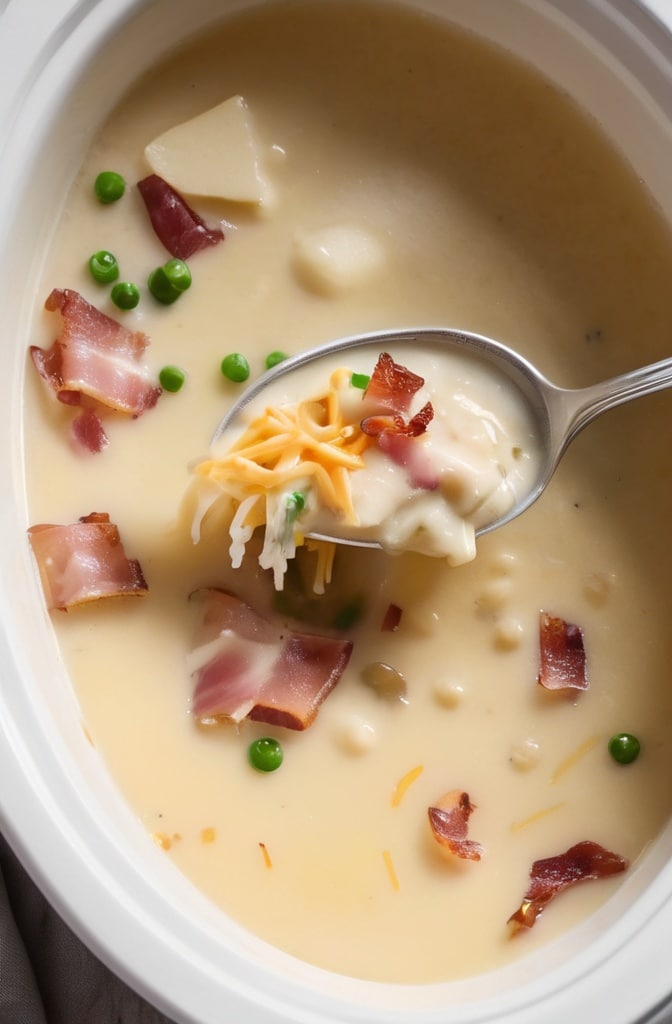Have you ever walked into your home after a long winter day to be greeted by the irresistible aroma of potato soup simmering away in the slow cooker? That first spoonful of creamy, comforting potato soup is like a warm embrace from the inside out. I still remember my grandmother’s kitchen in December, the windows fogged with condensation, her ancient crock pot bubbling away in the corner with what would become the most sought-after dish at family gatherings. That’s the magical power of a proper potato soup it ain’t just food, it’s a time machine.
Crock pot potato soup stands out from other versions because the slow, gentle cooking process allows the flavors to develop deeply while breaking down the potatoes just enough to create a naturally creamy texture. Unlike stovetop methods that require constant attention, this hands-off approach infuses every spoonful with a harmony of savory notes while the ingredients gradually meld together over hours. It’s comfort food science at its finest, transforming humble ingredients into something that feels positively luxurious.
Ingredients & Substitutions
The Foundation
- 2 pounds Yukon Gold potatoes, peeled and diced into 1-inch chunks
- 1 large yellow onion, finely diced
- 3 cloves garlic, minced or pressed
- 4 cups chicken broth (or vegetable broth for vegetarian option)
- 2 tablespoons unsalted butter
- 1 cup heavy cream
- 8 oz cream cheese, softened and cut into cubes
- 1/2 pound bacon, cooked and crumbled (reserve some for garnish)
- 1 cup sharp cheddar cheese, shredded (plus extra for garnish)
- 3 tablespoons all-purpose flour
- 1 teaspoon dried thyme
- 1/2 teaspoon dried oregano
- Salt and freshly ground black pepper to taste
- 1/4 cup fresh chives, chopped (for garnish)
The choice of potatoes here is deliberate and crucial. Yukon Golds have the perfect balance of starchiness and waxiness—they break down enough to thicken the soup naturally while maintaining just enough structure to avoid turning into complete mush. Russets would disintegrate too much, while red potatoes would hold their shape too well, not contributeing enough creaminess to the broth.
For those with dietary restrictions, several substitutions work beautifully without sacrificing flavor. Lactose-intolerant? Replace the heavy cream with full-fat coconut milk and use a plant-based cream cheese. The slight coconut flavor actually complements the potatoes surprisingly well. Vegetarians can skip the bacon and use vegetable broth—I recommend mushroom broth for its earthy depth. For a gluten-free version, substitute the flour with 2 tablespoons of cornstarch mixed with cold water.
The bacon provides that crucial smoky, savory note that elevates this soup from good to spectacular. I prefer applewood-smoked bacon, but any variety will work wonderfully. For a meatless alternative, a tablespoon of smoked paprika and a dash of liquid smoke provides similar depth. Fresh herbs are always preferable for garnish, but the dried herbs in the base work better during the long cooking process since fresh ones would lose there potency.
Step-by-Step Instructions

Preparation Phase
- Begin by peeling and dicing your potatoes into uniform 1-inch chunks. Consistency in size ensures they cook evenly. Pro tip: don’t rinse the cut potatoes the surface starch contributes to the soup’s velvety texture. A common mistake is cutting the potatoes too small, which can cause them to completely dissolve during the long cooking time.
- In a large skillet, cook the bacon until crispy. Transfer to paper towels to drain, then crumble when cool. Reserve about 2 tablespoons of the bacon fat and sauté the diced onion in it until translucent, about 5 minutes. Add the minced garlic and cook for another 30 seconds until fragrant but not browned. This pre-cooking step is crucial raw onions won’t properly soften in the crock pot, potentially leaving an unpleasant crunch.
- Transfer the onion-garlic mixture to your slow cooker. Add the diced potatoes, dried herbs, a generous pinch of salt, several grinds of black pepper, and the chicken broth. The broth should just barely cover the potatoes if it doesn’t, add a bit more. Cover and cook on low for 6-7 hours or on high for 3-4 hours. For an extra flavor boost, throw in a parmesan rind during cooking (just remember to fish it out later).
Creating the Creamy Base
- About 30 minutes before serving, in a small bowl, whisk together the flour and 1/2 cup of heavy cream until no lumps remain. This slurry will thicken the soup without creating floury clumps. Pour this mixture into the slow cooker, stirring gently to incorporate. For a dairy-free thickener, 3 tablespoons of cornstarch mixed with cold water works beautifully.
- Add the cubed cream cheese and butter, stirring until melted. The cream cheese is the secret weapon here—it adds a subtle tanginess that balances the richness and gives the soup body. If your cream cheese isn’t melting smoothly, cut it into smaller pieces and let them sit in the hot soup for a few minutes before attempting to stir.
- Stir in the remaining heavy cream and about three-quarters of the crumbled bacon (save the rest for garnish). Add the shredded cheddar cheese and stir until completely melted. Continue cooking on high for an additional 15 minutes. The soup will thicken as it cooks, but if it’s still too thin, mix another tablespoon of flour with cold water and stir it in. Too thick? Add a splash more broth.
Final Touches
- Before serving, taste and adjust seasoning. Potatoes absorb an incredible amount of salt during cooking, so you’ll likely need to add more than you initially think. A surprising addition that works wonders is a tiny splash of apple cider vinegar or lemon juice just a teaspoon brightens all the flavors without making the soup taste acidic.
- Serve hot, garnished with the reserved bacon crumbles, additional shredded cheese, and fresh chives. For texture contrast, buttery croutons or oyster crackers make excellent toppers. For a gourmet variation, try a small drizzle of truffle oil or a sprinkle of smoked salt as a finishing touch.
Cooking Techniques & Science
The magic of slow-cooker potato soup lies in the gentle, extended cooking process that fundamentally alters the character of the ingredients. When potatoes are subjected to prolonged, low heat, their cell walls gradually break down in a way that’s dramatically different from the rapid cooking of stovetop methods. This slow breakdown releases amylose (a type of starch) into the surrounding liquid, creating a naturally thickened base without requiring excessive flour or other thickeners.
The science of this soup is fascinatin’. During the 6+ hour cooking process, the potato starches gelatinize, absorbing liquid and swelling. Some of the potato cells rupture, releasing their starchy contents, while others remain intact, providing textural contrast. Yukon Golds are ideal because they contain a moderate amount of amylopectin (another starch type) that helps them maintain some structure while still contributing to the soup’s creaminess.
Temperature control is crucial to the success of this dish. Most slow cookers operate at around 200°F on the low setting, which is the perfect temperature for gently breaking down potatoes without causing dairy to separate. This is why we add the cream components toward the end of cooking rather than at the beginning prolonged heating would cause the fats to separate, resulting in a greasy, broken soup. The addition of flour or cornstarch provides insurance against separation by stabilizing the emulsion.
A 6-quart oval slow cooker provides the ideal cooking environment for this recipe. The shape allows for proper heat circulation, while the size accommodates the ingredients without overcrowding. If using a newer model with higher temperature settings, you may need to reduce the cooking time slightly. The lid’s role is crucial it traps steam, creating a moist cooking environment that helps break down the potatoes efficiently.
Serving & Pairing Suggestions

Presentation elevates this humble soup to something special. Always serve in pre-warmed bowls nothing ruins a potatoe soup faster than a cold bowl that causes the creamy texture to seize up. Create a “garnish bar” with small bowls of toppings, allowing each person to customize their soup. Beyond the classic bacon, cheese, and chives, consider offering caramelized onions, roasted garlic, crispy fried shallots, or even everything bagel seasoning.
The texture should be velvety but with some small potato chunks remaining for interest. If serving for a special occasion, consider passing half the soup through a fine-mesh strainer for the smoothest possible consistency, then reintroducing it to the portion with potato pieces. This creates a luxurious mouthfeel while maintaining textural complexity.
For a complete meal, pair this rich soup with contrasting flavors and textures. A crisp green salad with a bright vinaigrette cuts through the creaminess beautifully think arugula with lemon dressing or a simple slaw with apple cider vinegar. For bread, a crusty sourdough or hearty rye provides the perfect vehicle for dipping and sopping up every last drop.
Beverage pairings depend on the occasion. For a casual family meal, a crisp hard cider or amber ale complements the soup’s rich flavors. For a more sophisticated pairing, consider a medium-bodied white wine like an unoaked Chardonnay or Viognier. The acidity and fruit notes provide a pleasing contrast to the soup’s creaminess. For non-alcoholic options, sparkling water with a squeeze of lemon refreshes the palate between spoonfuls.
This soup reheats beautifully, possibly even improving after a day in the refrigerator as the flavors meld further. When reheating, do so gently over low heat, stirring occasionally and adding a splash of broth if needed to thin it back out. For meal prep, you can freeze the soup before adding the dairy components, then add them fresh when reheating.
Conclusion
Crock pot potato soup represents the perfect intersection of convenience and culinary excellence simple ingredients transformed through proper technique into a dish that’s greater than the sum of its parts. The slow cooker doesn’t just make this recipe easier; it fundamentally improves it through the gentle, extended cooking process that traditional stovetop methods can’t replicate.
What makes this version truly special is its balance of textures and flavors creamy without being heavy, richly savory with hints of herbs and smokiness from the bacon, and endlessly customizable through garnishes and slight variations. It’s a recipe that works equally well for a quiet family dinner or as the first course of a special gathering. The techniques learned here from proper potato selection to the timing of dairy additions transfer beautifully to other slow cooker soups.
The beauty of mastering this dish is that it opens the door to countless variations. Once you understand the basic principles, you can create your own signature versions perhaps with leeks instead of onions, roasted garlic instead of raw, or with the addition of corn, celery, or even seafood. Don’t be afraid to experiment with different herbs or cheese combinations. A splash of white wine added with the stock creates a more complex flavor profile, while a pinch of nutmeg or white pepper adds subtle warmth.
Remember that the best potato soup isn’t just about following a recipe it’s about understanding why each step matters and how the ingredients interact. Weather you stick closely to this version or use it as inspiration for your own creation, the result will be a soul-warming dish that brings people together around the table. And isnt that what cooking is truly about?
FAQs
Can I make this soup ahead of time?
Absolutely! This soup actually improves after a day in the refrigerator as the flavors meld together more deeply. Make it through step 6, cool completely, and refrigerate for up to 3 days. When ready to serve, reheat gently on the stovetop or in the slow cooker on low, adding a splash more broth if needed to thin it out. Add the fresh garnishes just before serving for the best texture and appearance.
My soup is too thin. How can I thicken it?
If your soup hasn’t reached your desired consistency, you have several options. The easiest is to continue cooking with the lid off for 30-60 minutes to allow some liquid to evaporate. Alternatively, make another slurry with 1 tablespoon flour or cornstarch mixed with 2 tablespoons cold water, then stir it in and cook for another 15 minutes. For a more rustic approach, you can also mash some of the potatoes against the side of the pot with a wooden spoon to release more starch.
Can I freeze this soup?
Dairy-based soups can be tricky to freeze because they tend to separate and become grainy when thawed. For best results, make the soup without adding the dairy components (cream, cream cheese, butter, and cheese). Freeze this base for up to 3 months, then add the dairy ingredients fresh when reheating. If you must freeze the complete soup, reheat it very slowly and whisk vigorously to recombine the ingredients. A splash of fresh cream added during reheating helps restore the original texture.
What can I add to make this soup more substantial as a main course?
To transform this into a heartier main dish, consider adding protein like diced ham, shredded rotisserie chicken, or even browned ground sausage. For a seafood variation, cooked shrimp or crab meat added just before serving works beautifully. You can also add more vegetables like corn, peas, carrots, or celery. For an autumn twist, roasted butternut squash cubes add wonderful color and sweetness. Even a can of drained white beans adds protein and fiber without disrupting the soup’s character.

